Methods and Techniques in Highway Design
VerifiedAdded on 2023/04/08
|15
|2291
|226
AI Summary
This document discusses the methods and techniques used in highway design, including the profile, alignment, and cross-section. It emphasizes the importance of following design standards and guidelines to ensure safe and comfortable roads for users.
Contribute Materials
Your contribution can guide someone’s learning journey. Share your
documents today.
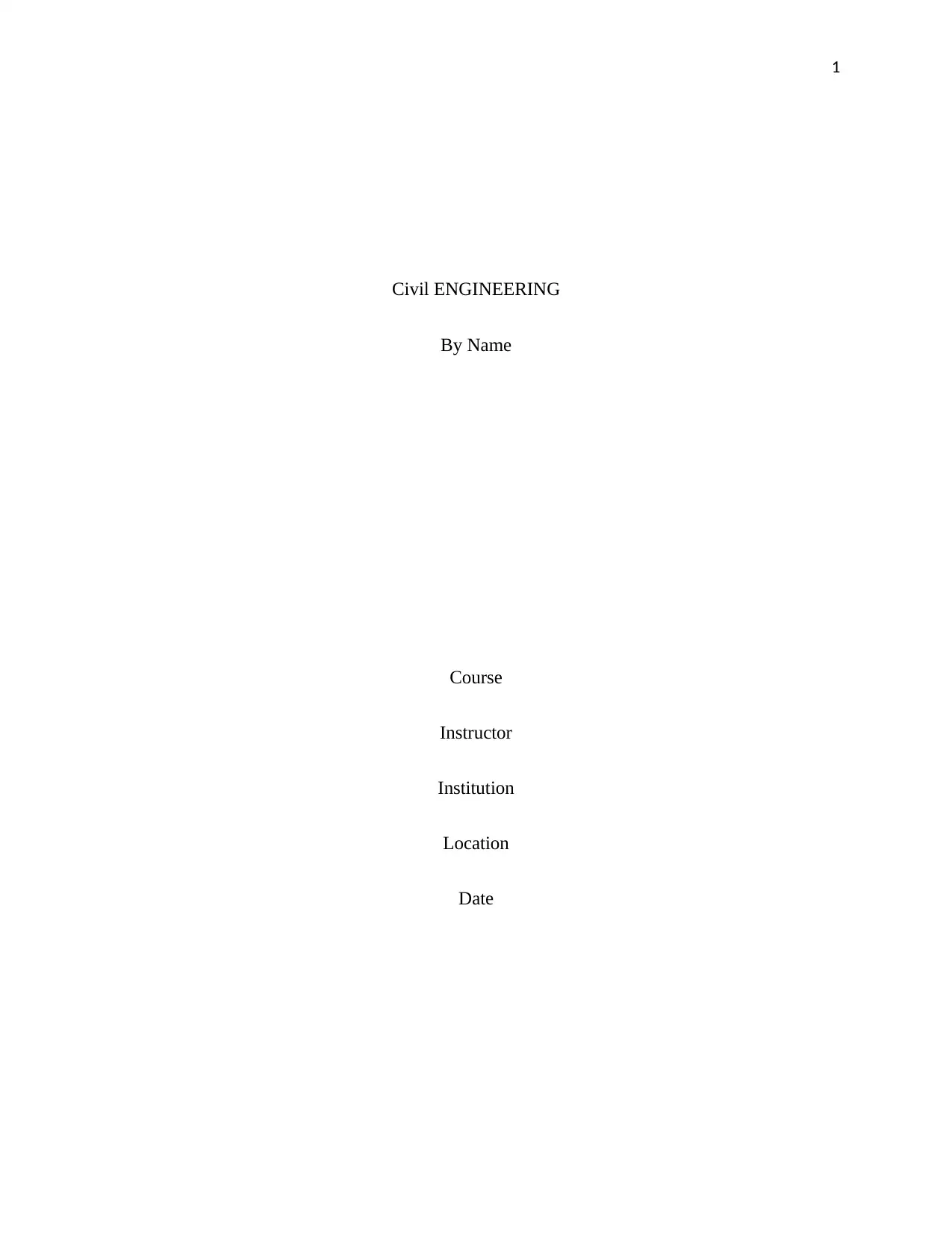
1
Civil ENGINEERING
By Name
Course
Instructor
Institution
Location
Date
Civil ENGINEERING
By Name
Course
Instructor
Institution
Location
Date
Secure Best Marks with AI Grader
Need help grading? Try our AI Grader for instant feedback on your assignments.
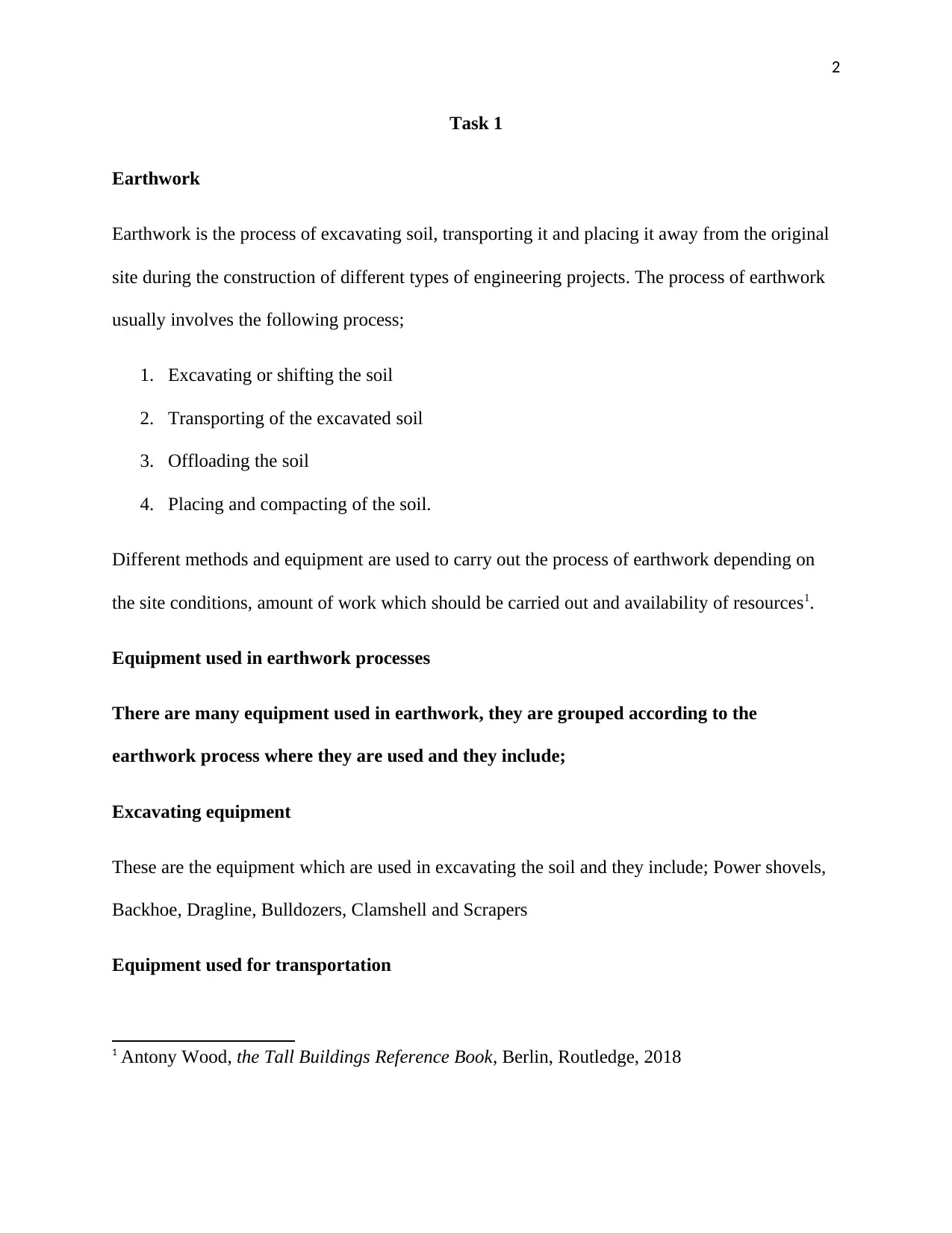
2
Task 1
Earthwork
Earthwork is the process of excavating soil, transporting it and placing it away from the original
site during the construction of different types of engineering projects. The process of earthwork
usually involves the following process;
1. Excavating or shifting the soil
2. Transporting of the excavated soil
3. Offloading the soil
4. Placing and compacting of the soil.
Different methods and equipment are used to carry out the process of earthwork depending on
the site conditions, amount of work which should be carried out and availability of resources1.
Equipment used in earthwork processes
There are many equipment used in earthwork, they are grouped according to the
earthwork process where they are used and they include;
Excavating equipment
These are the equipment which are used in excavating the soil and they include; Power shovels,
Backhoe, Dragline, Bulldozers, Clamshell and Scrapers
Equipment used for transportation
1 Antony Wood, the Tall Buildings Reference Book, Berlin, Routledge, 2018
Task 1
Earthwork
Earthwork is the process of excavating soil, transporting it and placing it away from the original
site during the construction of different types of engineering projects. The process of earthwork
usually involves the following process;
1. Excavating or shifting the soil
2. Transporting of the excavated soil
3. Offloading the soil
4. Placing and compacting of the soil.
Different methods and equipment are used to carry out the process of earthwork depending on
the site conditions, amount of work which should be carried out and availability of resources1.
Equipment used in earthwork processes
There are many equipment used in earthwork, they are grouped according to the
earthwork process where they are used and they include;
Excavating equipment
These are the equipment which are used in excavating the soil and they include; Power shovels,
Backhoe, Dragline, Bulldozers, Clamshell and Scrapers
Equipment used for transportation
1 Antony Wood, the Tall Buildings Reference Book, Berlin, Routledge, 2018
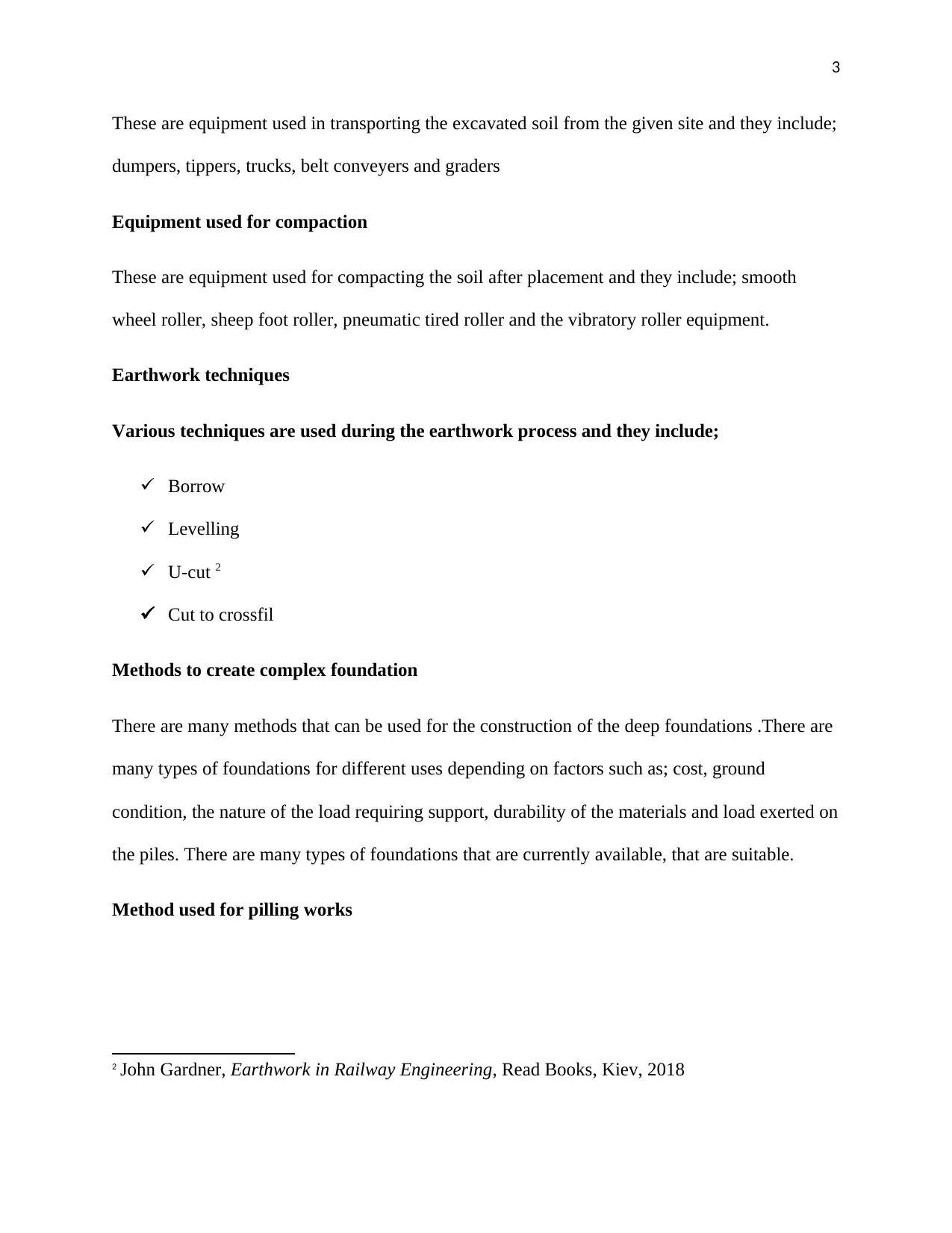
3
These are equipment used in transporting the excavated soil from the given site and they include;
dumpers, tippers, trucks, belt conveyers and graders
Equipment used for compaction
These are equipment used for compacting the soil after placement and they include; smooth
wheel roller, sheep foot roller, pneumatic tired roller and the vibratory roller equipment.
Earthwork techniques
Various techniques are used during the earthwork process and they include;
Borrow
Levelling
U-cut 2
Cut to crossfil
Methods to create complex foundation
There are many methods that can be used for the construction of the deep foundations .There are
many types of foundations for different uses depending on factors such as; cost, ground
condition, the nature of the load requiring support, durability of the materials and load exerted on
the piles. There are many types of foundations that are currently available, that are suitable.
Method used for pilling works
2 John Gardner, Earthwork in Railway Engineering, Read Books, Kiev, 2018
These are equipment used in transporting the excavated soil from the given site and they include;
dumpers, tippers, trucks, belt conveyers and graders
Equipment used for compaction
These are equipment used for compacting the soil after placement and they include; smooth
wheel roller, sheep foot roller, pneumatic tired roller and the vibratory roller equipment.
Earthwork techniques
Various techniques are used during the earthwork process and they include;
Borrow
Levelling
U-cut 2
Cut to crossfil
Methods to create complex foundation
There are many methods that can be used for the construction of the deep foundations .There are
many types of foundations for different uses depending on factors such as; cost, ground
condition, the nature of the load requiring support, durability of the materials and load exerted on
the piles. There are many types of foundations that are currently available, that are suitable.
Method used for pilling works
2 John Gardner, Earthwork in Railway Engineering, Read Books, Kiev, 2018
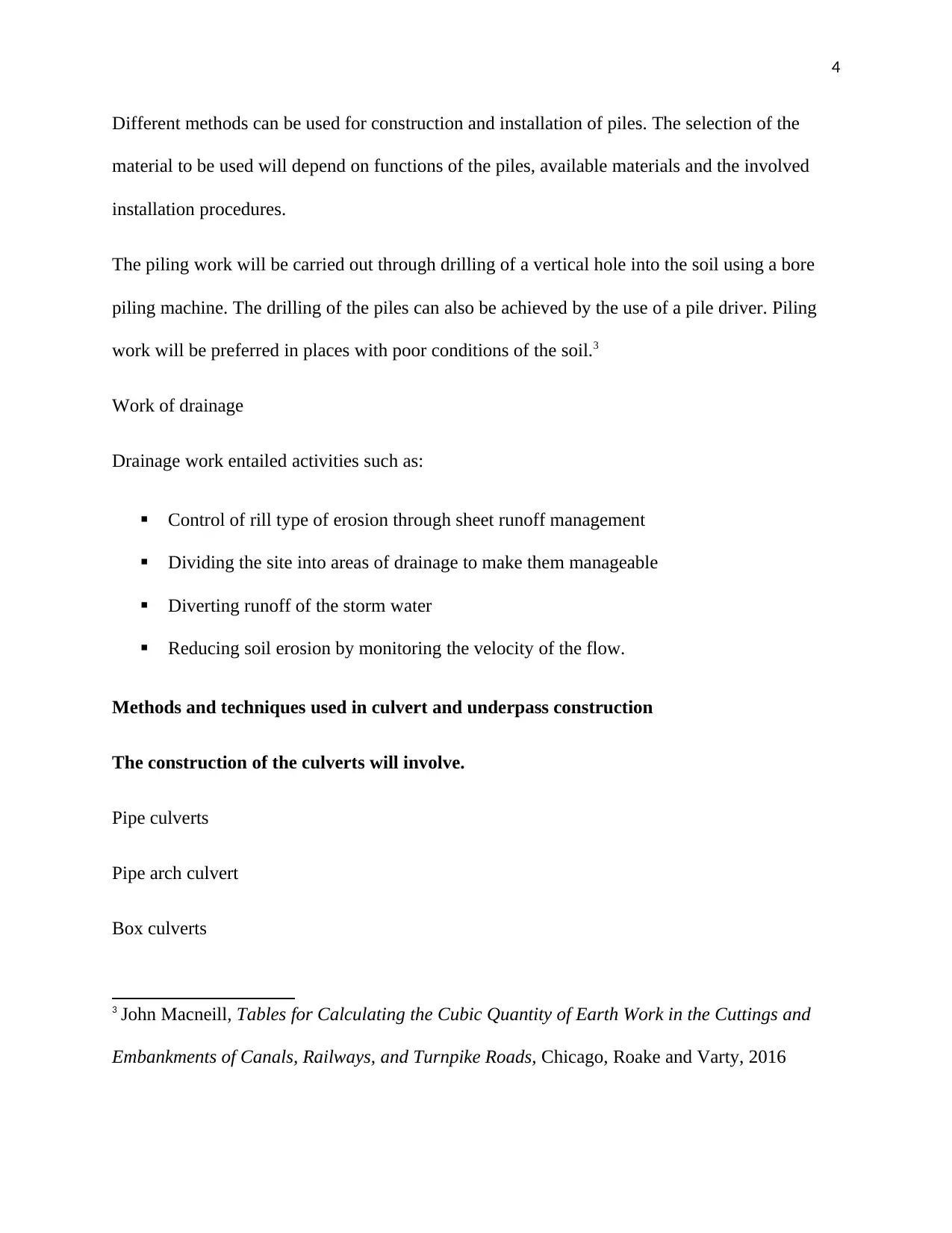
4
Different methods can be used for construction and installation of piles. The selection of the
material to be used will depend on functions of the piles, available materials and the involved
installation procedures.
The piling work will be carried out through drilling of a vertical hole into the soil using a bore
piling machine. The drilling of the piles can also be achieved by the use of a pile driver. Piling
work will be preferred in places with poor conditions of the soil.3
Work of drainage
Drainage work entailed activities such as:
Control of rill type of erosion through sheet runoff management
Dividing the site into areas of drainage to make them manageable
Diverting runoff of the storm water
Reducing soil erosion by monitoring the velocity of the flow.
Methods and techniques used in culvert and underpass construction
The construction of the culverts will involve.
Pipe culverts
Pipe arch culvert
Box culverts
3 John Macneill, Tables for Calculating the Cubic Quantity of Earth Work in the Cuttings and
Embankments of Canals, Railways, and Turnpike Roads, Chicago, Roake and Varty, 2016
Different methods can be used for construction and installation of piles. The selection of the
material to be used will depend on functions of the piles, available materials and the involved
installation procedures.
The piling work will be carried out through drilling of a vertical hole into the soil using a bore
piling machine. The drilling of the piles can also be achieved by the use of a pile driver. Piling
work will be preferred in places with poor conditions of the soil.3
Work of drainage
Drainage work entailed activities such as:
Control of rill type of erosion through sheet runoff management
Dividing the site into areas of drainage to make them manageable
Diverting runoff of the storm water
Reducing soil erosion by monitoring the velocity of the flow.
Methods and techniques used in culvert and underpass construction
The construction of the culverts will involve.
Pipe culverts
Pipe arch culvert
Box culverts
3 John Macneill, Tables for Calculating the Cubic Quantity of Earth Work in the Cuttings and
Embankments of Canals, Railways, and Turnpike Roads, Chicago, Roake and Varty, 2016
Secure Best Marks with AI Grader
Need help grading? Try our AI Grader for instant feedback on your assignments.
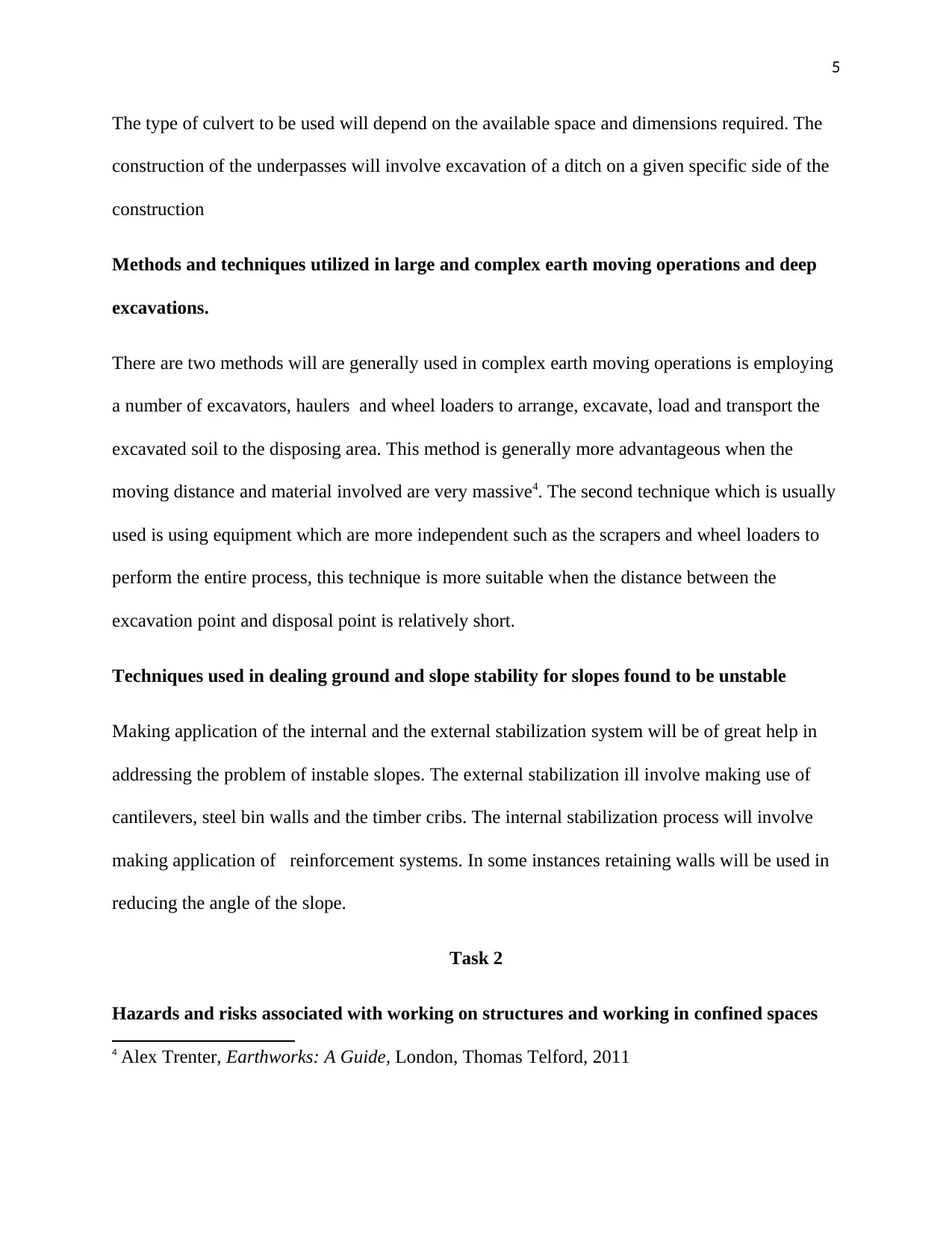
5
The type of culvert to be used will depend on the available space and dimensions required. The
construction of the underpasses will involve excavation of a ditch on a given specific side of the
construction
Methods and techniques utilized in large and complex earth moving operations and deep
excavations.
There are two methods will are generally used in complex earth moving operations is employing
a number of excavators, haulers and wheel loaders to arrange, excavate, load and transport the
excavated soil to the disposing area. This method is generally more advantageous when the
moving distance and material involved are very massive4. The second technique which is usually
used is using equipment which are more independent such as the scrapers and wheel loaders to
perform the entire process, this technique is more suitable when the distance between the
excavation point and disposal point is relatively short.
Techniques used in dealing ground and slope stability for slopes found to be unstable
Making application of the internal and the external stabilization system will be of great help in
addressing the problem of instable slopes. The external stabilization ill involve making use of
cantilevers, steel bin walls and the timber cribs. The internal stabilization process will involve
making application of reinforcement systems. In some instances retaining walls will be used in
reducing the angle of the slope.
Task 2
Hazards and risks associated with working on structures and working in confined spaces
4 Alex Trenter, Earthworks: A Guide, London, Thomas Telford, 2011
The type of culvert to be used will depend on the available space and dimensions required. The
construction of the underpasses will involve excavation of a ditch on a given specific side of the
construction
Methods and techniques utilized in large and complex earth moving operations and deep
excavations.
There are two methods will are generally used in complex earth moving operations is employing
a number of excavators, haulers and wheel loaders to arrange, excavate, load and transport the
excavated soil to the disposing area. This method is generally more advantageous when the
moving distance and material involved are very massive4. The second technique which is usually
used is using equipment which are more independent such as the scrapers and wheel loaders to
perform the entire process, this technique is more suitable when the distance between the
excavation point and disposal point is relatively short.
Techniques used in dealing ground and slope stability for slopes found to be unstable
Making application of the internal and the external stabilization system will be of great help in
addressing the problem of instable slopes. The external stabilization ill involve making use of
cantilevers, steel bin walls and the timber cribs. The internal stabilization process will involve
making application of reinforcement systems. In some instances retaining walls will be used in
reducing the angle of the slope.
Task 2
Hazards and risks associated with working on structures and working in confined spaces
4 Alex Trenter, Earthworks: A Guide, London, Thomas Telford, 2011
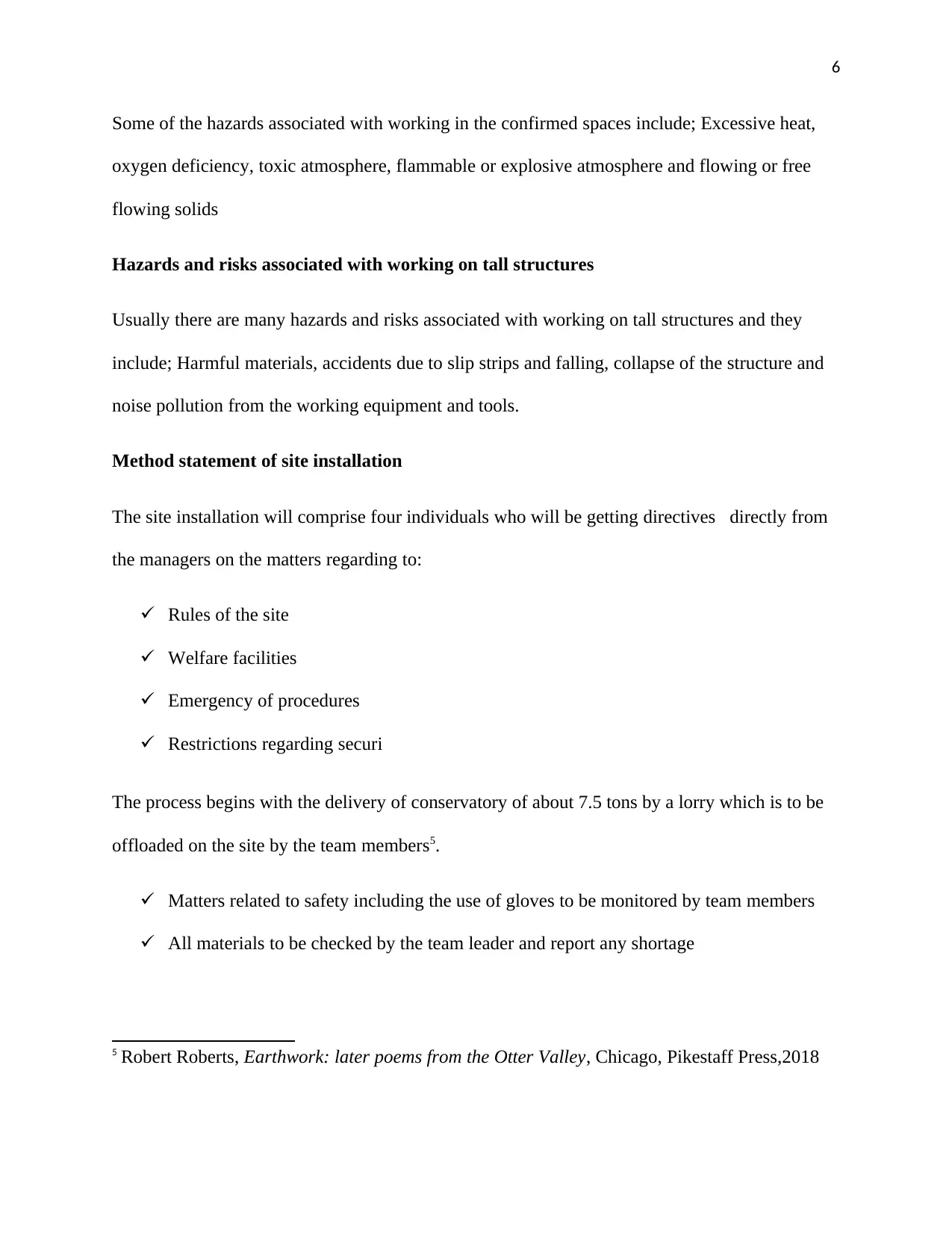
6
Some of the hazards associated with working in the confirmed spaces include; Excessive heat,
oxygen deficiency, toxic atmosphere, flammable or explosive atmosphere and flowing or free
flowing solids
Hazards and risks associated with working on tall structures
Usually there are many hazards and risks associated with working on tall structures and they
include; Harmful materials, accidents due to slip strips and falling, collapse of the structure and
noise pollution from the working equipment and tools.
Method statement of site installation
The site installation will comprise four individuals who will be getting directives directly from
the managers on the matters regarding to:
Rules of the site
Welfare facilities
Emergency of procedures
Restrictions regarding securi
The process begins with the delivery of conservatory of about 7.5 tons by a lorry which is to be
offloaded on the site by the team members5.
Matters related to safety including the use of gloves to be monitored by team members
All materials to be checked by the team leader and report any shortage
5 Robert Roberts, Earthwork: later poems from the Otter Valley, Chicago, Pikestaff Press,2018
Some of the hazards associated with working in the confirmed spaces include; Excessive heat,
oxygen deficiency, toxic atmosphere, flammable or explosive atmosphere and flowing or free
flowing solids
Hazards and risks associated with working on tall structures
Usually there are many hazards and risks associated with working on tall structures and they
include; Harmful materials, accidents due to slip strips and falling, collapse of the structure and
noise pollution from the working equipment and tools.
Method statement of site installation
The site installation will comprise four individuals who will be getting directives directly from
the managers on the matters regarding to:
Rules of the site
Welfare facilities
Emergency of procedures
Restrictions regarding securi
The process begins with the delivery of conservatory of about 7.5 tons by a lorry which is to be
offloaded on the site by the team members5.
Matters related to safety including the use of gloves to be monitored by team members
All materials to be checked by the team leader and report any shortage
5 Robert Roberts, Earthwork: later poems from the Otter Valley, Chicago, Pikestaff Press,2018
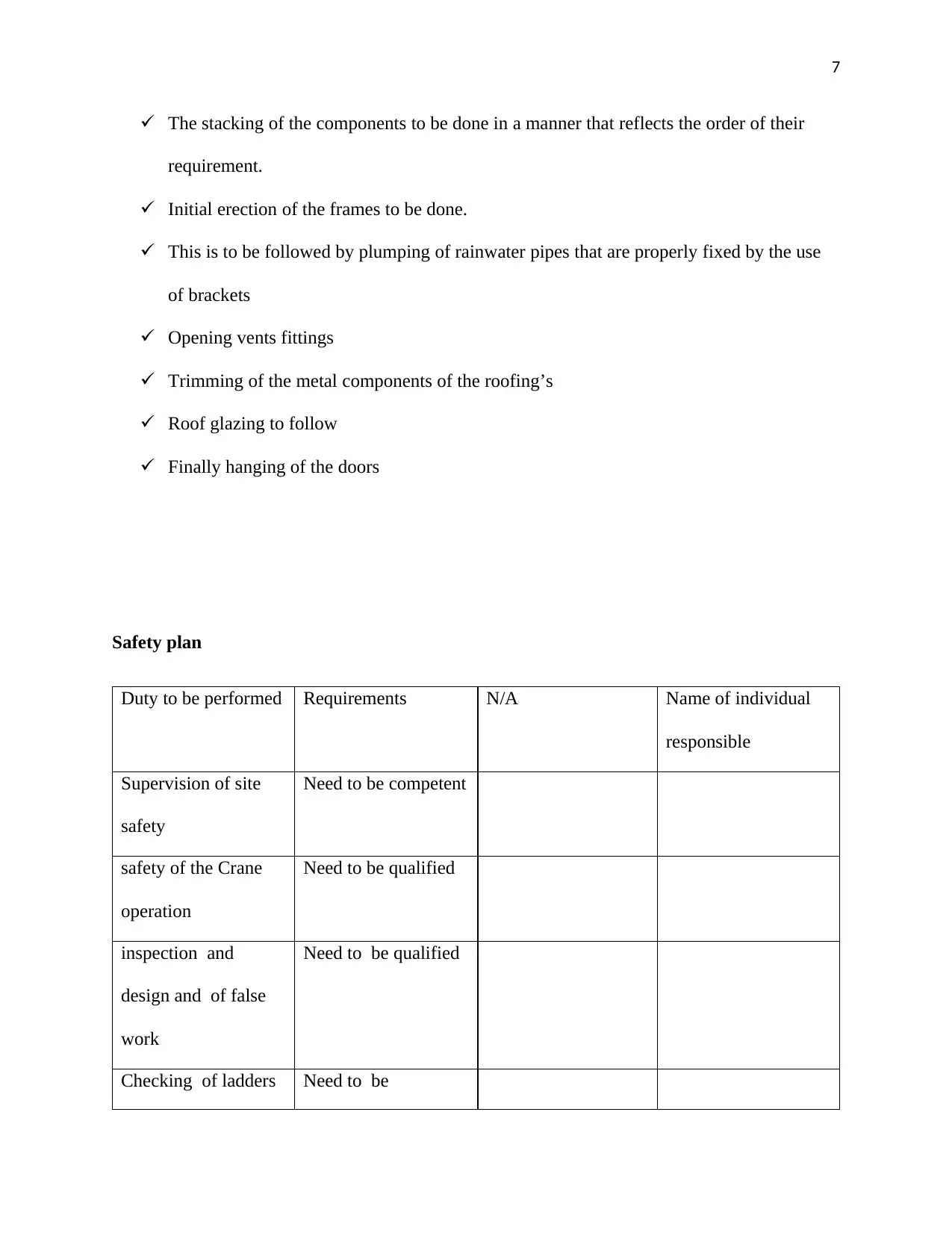
7
The stacking of the components to be done in a manner that reflects the order of their
requirement.
Initial erection of the frames to be done.
This is to be followed by plumping of rainwater pipes that are properly fixed by the use
of brackets
Opening vents fittings
Trimming of the metal components of the roofing’s
Roof glazing to follow
Finally hanging of the doors
Safety plan
Duty to be performed Requirements N/A Name of individual
responsible
Supervision of site
safety
Need to be competent
safety of the Crane
operation
Need to be qualified
inspection and
design and of false
work
Need to be qualified
Checking of ladders Need to be
The stacking of the components to be done in a manner that reflects the order of their
requirement.
Initial erection of the frames to be done.
This is to be followed by plumping of rainwater pipes that are properly fixed by the use
of brackets
Opening vents fittings
Trimming of the metal components of the roofing’s
Roof glazing to follow
Finally hanging of the doors
Safety plan
Duty to be performed Requirements N/A Name of individual
responsible
Supervision of site
safety
Need to be competent
safety of the Crane
operation
Need to be qualified
inspection and
design and of false
work
Need to be qualified
Checking of ladders Need to be
Paraphrase This Document
Need a fresh take? Get an instant paraphrase of this document with our AI Paraphraser
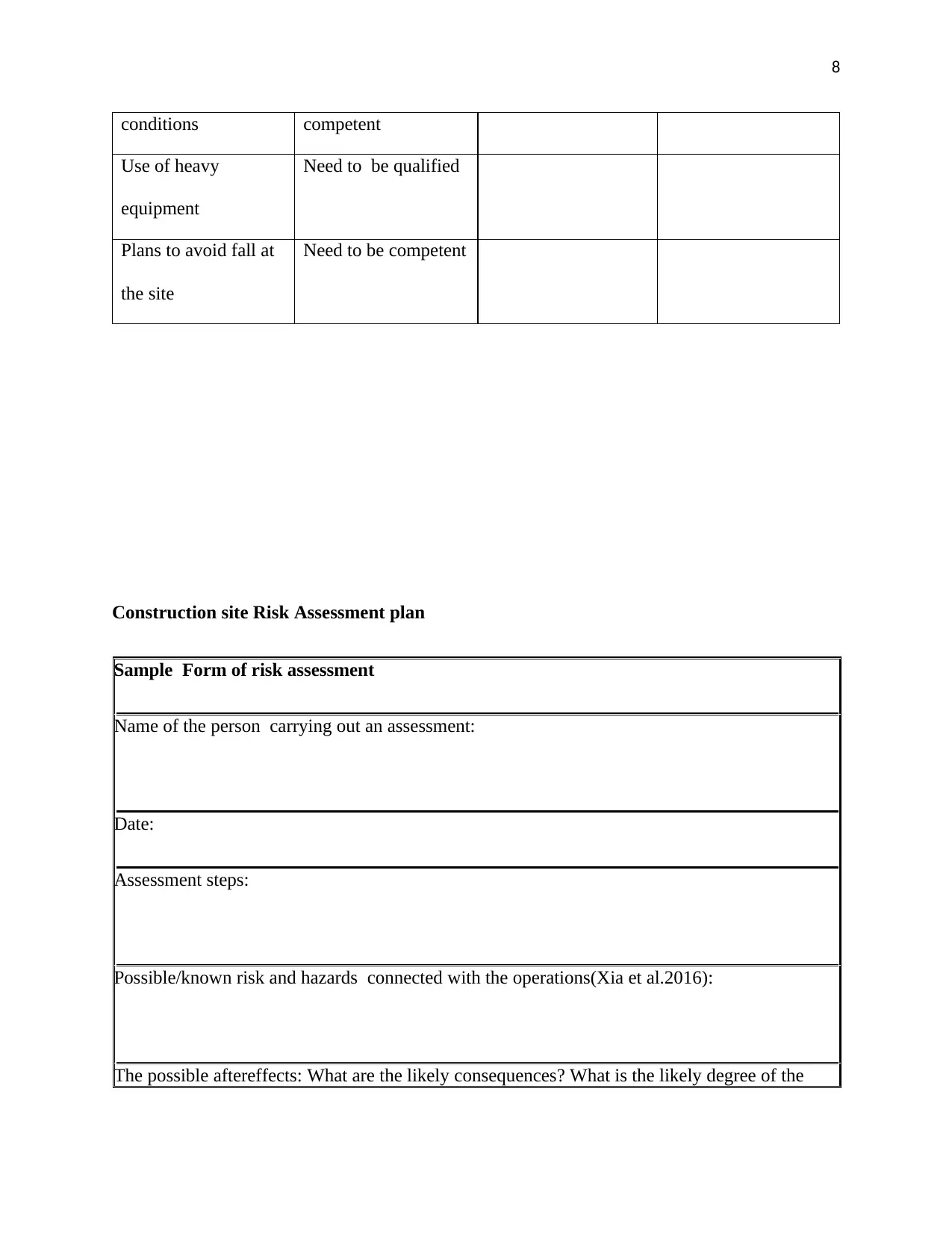
8
conditions competent
Use of heavy
equipment
Need to be qualified
Plans to avoid fall at
the site
Need to be competent
Construction site Risk Assessment plan
Sample Form of risk assessment
Name of the person carrying out an assessment:
Date:
Assessment steps:
Possible/known risk and hazards connected with the operations(Xia et al.2016):
The possible aftereffects: What are the likely consequences? What is the likely degree of the
conditions competent
Use of heavy
equipment
Need to be qualified
Plans to avoid fall at
the site
Need to be competent
Construction site Risk Assessment plan
Sample Form of risk assessment
Name of the person carrying out an assessment:
Date:
Assessment steps:
Possible/known risk and hazards connected with the operations(Xia et al.2016):
The possible aftereffects: What are the likely consequences? What is the likely degree of the
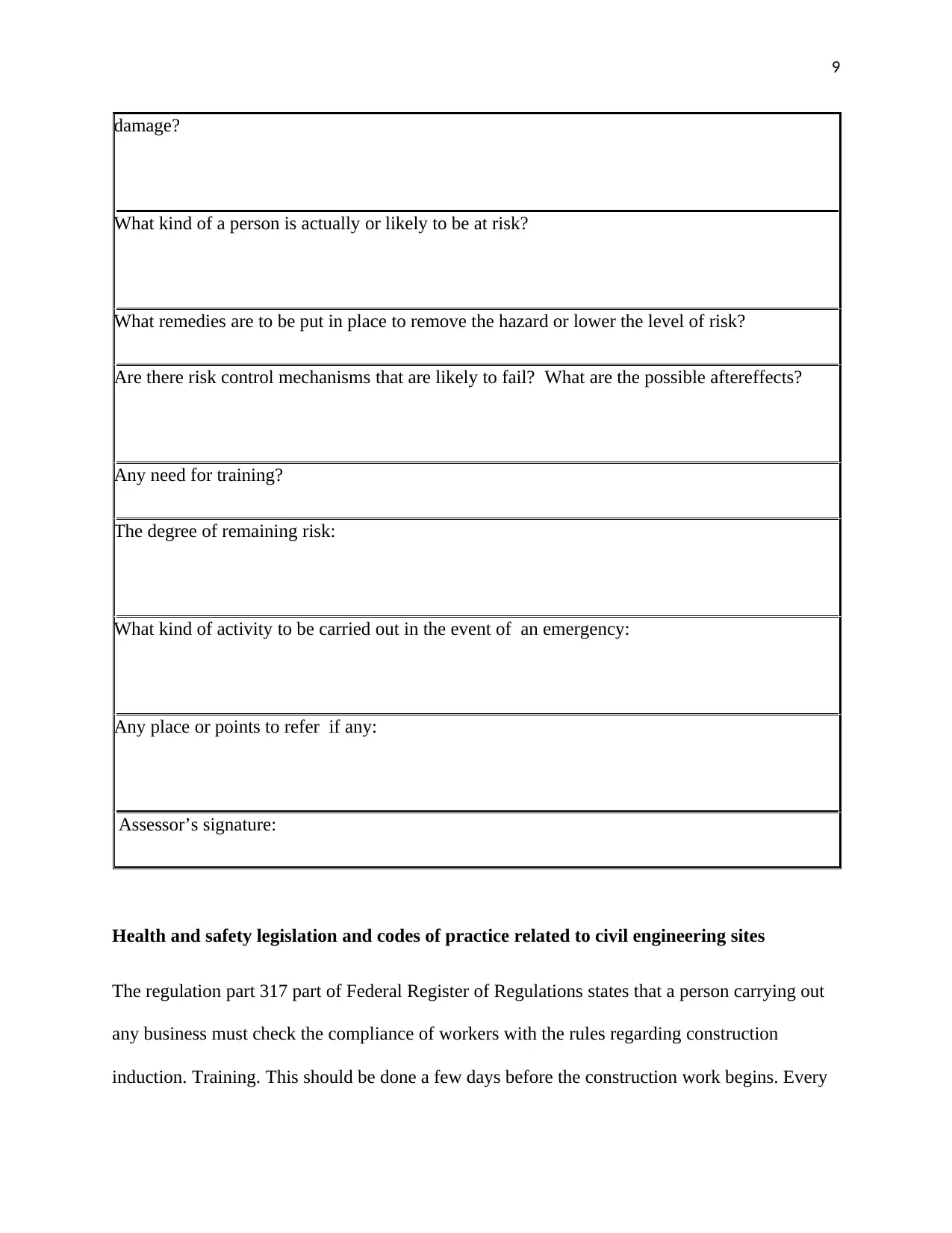
9
damage?
What kind of a person is actually or likely to be at risk?
What remedies are to be put in place to remove the hazard or lower the level of risk?
Are there risk control mechanisms that are likely to fail? What are the possible aftereffects?
Any need for training?
The degree of remaining risk:
What kind of activity to be carried out in the event of an emergency:
Any place or points to refer if any:
Assessor’s signature:
Health and safety legislation and codes of practice related to civil engineering sites
The regulation part 317 part of Federal Register of Regulations states that a person carrying out
any business must check the compliance of workers with the rules regarding construction
induction. Training. This should be done a few days before the construction work begins. Every
damage?
What kind of a person is actually or likely to be at risk?
What remedies are to be put in place to remove the hazard or lower the level of risk?
Are there risk control mechanisms that are likely to fail? What are the possible aftereffects?
Any need for training?
The degree of remaining risk:
What kind of activity to be carried out in the event of an emergency:
Any place or points to refer if any:
Assessor’s signature:
Health and safety legislation and codes of practice related to civil engineering sites
The regulation part 317 part of Federal Register of Regulations states that a person carrying out
any business must check the compliance of workers with the rules regarding construction
induction. Training. This should be done a few days before the construction work begins. Every
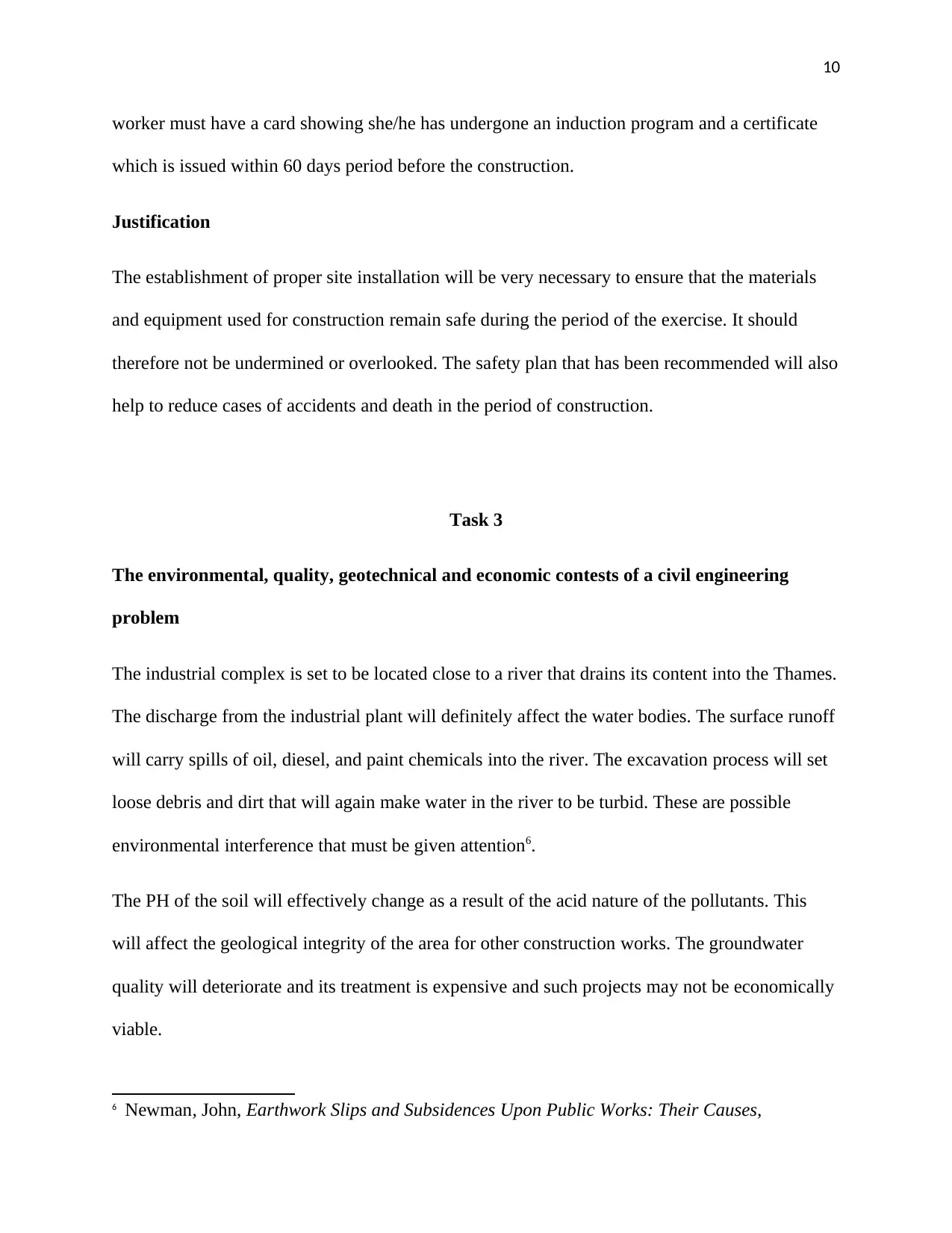
10
worker must have a card showing she/he has undergone an induction program and a certificate
which is issued within 60 days period before the construction.
Justification
The establishment of proper site installation will be very necessary to ensure that the materials
and equipment used for construction remain safe during the period of the exercise. It should
therefore not be undermined or overlooked. The safety plan that has been recommended will also
help to reduce cases of accidents and death in the period of construction.
Task 3
The environmental, quality, geotechnical and economic contests of a civil engineering
problem
The industrial complex is set to be located close to a river that drains its content into the Thames.
The discharge from the industrial plant will definitely affect the water bodies. The surface runoff
will carry spills of oil, diesel, and paint chemicals into the river. The excavation process will set
loose debris and dirt that will again make water in the river to be turbid. These are possible
environmental interference that must be given attention6.
The PH of the soil will effectively change as a result of the acid nature of the pollutants. This
will affect the geological integrity of the area for other construction works. The groundwater
quality will deteriorate and its treatment is expensive and such projects may not be economically
viable.
6 Newman, John, Earthwork Slips and Subsidences Upon Public Works: Their Causes,
worker must have a card showing she/he has undergone an induction program and a certificate
which is issued within 60 days period before the construction.
Justification
The establishment of proper site installation will be very necessary to ensure that the materials
and equipment used for construction remain safe during the period of the exercise. It should
therefore not be undermined or overlooked. The safety plan that has been recommended will also
help to reduce cases of accidents and death in the period of construction.
Task 3
The environmental, quality, geotechnical and economic contests of a civil engineering
problem
The industrial complex is set to be located close to a river that drains its content into the Thames.
The discharge from the industrial plant will definitely affect the water bodies. The surface runoff
will carry spills of oil, diesel, and paint chemicals into the river. The excavation process will set
loose debris and dirt that will again make water in the river to be turbid. These are possible
environmental interference that must be given attention6.
The PH of the soil will effectively change as a result of the acid nature of the pollutants. This
will affect the geological integrity of the area for other construction works. The groundwater
quality will deteriorate and its treatment is expensive and such projects may not be economically
viable.
6 Newman, John, Earthwork Slips and Subsidences Upon Public Works: Their Causes,
Secure Best Marks with AI Grader
Need help grading? Try our AI Grader for instant feedback on your assignments.
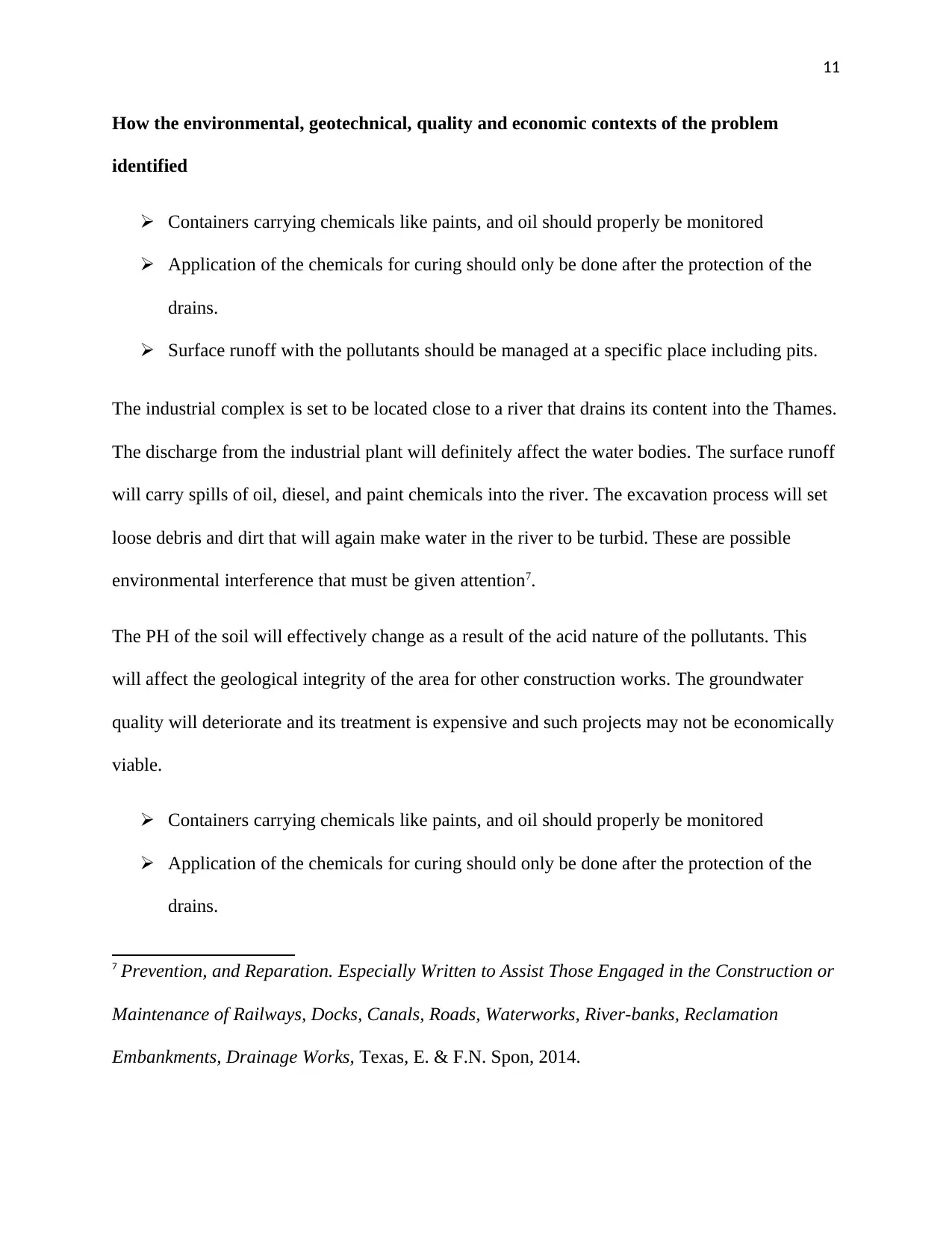
11
How the environmental, geotechnical, quality and economic contexts of the problem
identified
Containers carrying chemicals like paints, and oil should properly be monitored
Application of the chemicals for curing should only be done after the protection of the
drains.
Surface runoff with the pollutants should be managed at a specific place including pits.
The industrial complex is set to be located close to a river that drains its content into the Thames.
The discharge from the industrial plant will definitely affect the water bodies. The surface runoff
will carry spills of oil, diesel, and paint chemicals into the river. The excavation process will set
loose debris and dirt that will again make water in the river to be turbid. These are possible
environmental interference that must be given attention7.
The PH of the soil will effectively change as a result of the acid nature of the pollutants. This
will affect the geological integrity of the area for other construction works. The groundwater
quality will deteriorate and its treatment is expensive and such projects may not be economically
viable.
Containers carrying chemicals like paints, and oil should properly be monitored
Application of the chemicals for curing should only be done after the protection of the
drains.
7 Prevention, and Reparation. Especially Written to Assist Those Engaged in the Construction or
Maintenance of Railways, Docks, Canals, Roads, Waterworks, River-banks, Reclamation
Embankments, Drainage Works, Texas, E. & F.N. Spon, 2014.
How the environmental, geotechnical, quality and economic contexts of the problem
identified
Containers carrying chemicals like paints, and oil should properly be monitored
Application of the chemicals for curing should only be done after the protection of the
drains.
Surface runoff with the pollutants should be managed at a specific place including pits.
The industrial complex is set to be located close to a river that drains its content into the Thames.
The discharge from the industrial plant will definitely affect the water bodies. The surface runoff
will carry spills of oil, diesel, and paint chemicals into the river. The excavation process will set
loose debris and dirt that will again make water in the river to be turbid. These are possible
environmental interference that must be given attention7.
The PH of the soil will effectively change as a result of the acid nature of the pollutants. This
will affect the geological integrity of the area for other construction works. The groundwater
quality will deteriorate and its treatment is expensive and such projects may not be economically
viable.
Containers carrying chemicals like paints, and oil should properly be monitored
Application of the chemicals for curing should only be done after the protection of the
drains.
7 Prevention, and Reparation. Especially Written to Assist Those Engaged in the Construction or
Maintenance of Railways, Docks, Canals, Roads, Waterworks, River-banks, Reclamation
Embankments, Drainage Works, Texas, E. & F.N. Spon, 2014.
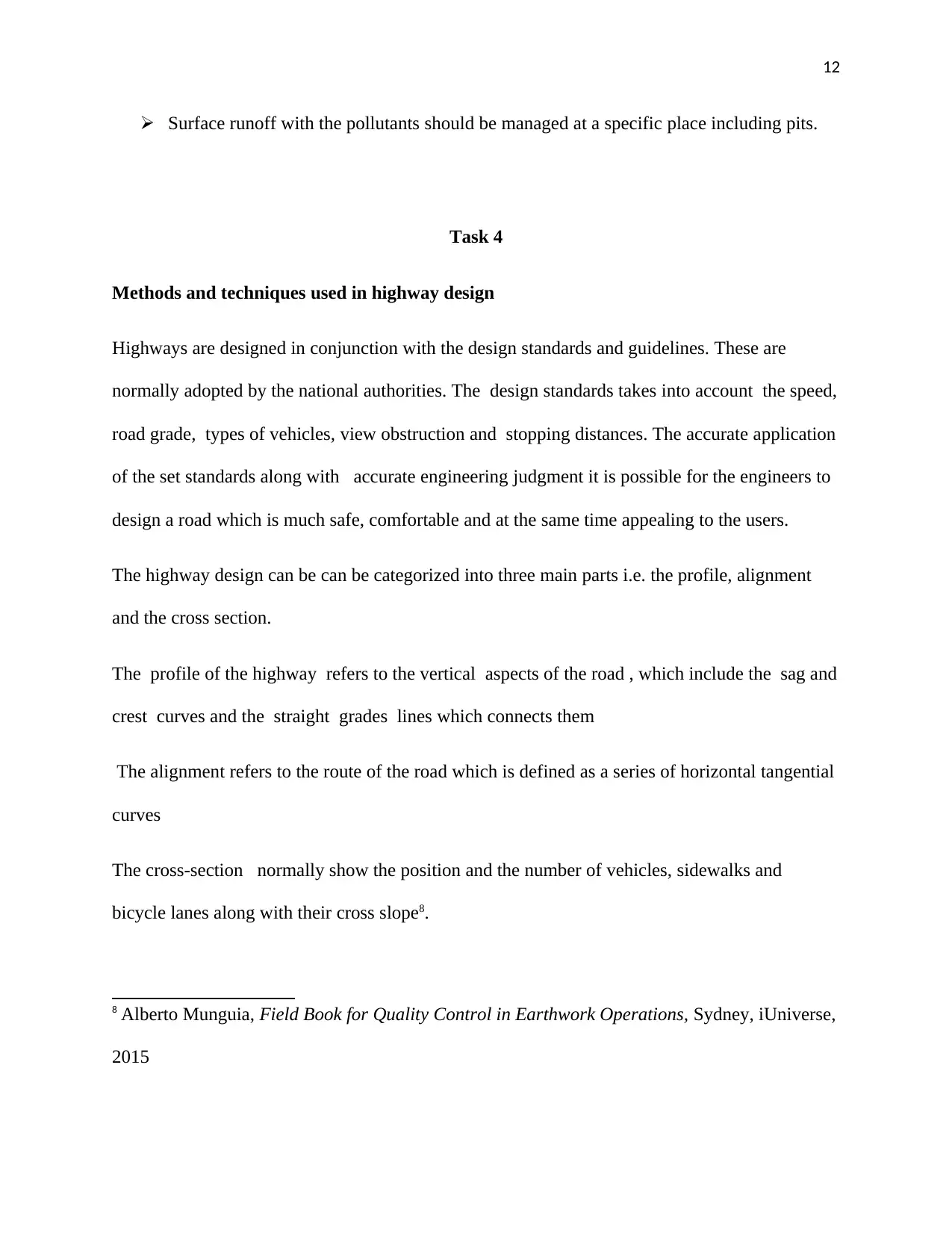
12
Surface runoff with the pollutants should be managed at a specific place including pits.
Task 4
Methods and techniques used in highway design
Highways are designed in conjunction with the design standards and guidelines. These are
normally adopted by the national authorities. The design standards takes into account the speed,
road grade, types of vehicles, view obstruction and stopping distances. The accurate application
of the set standards along with accurate engineering judgment it is possible for the engineers to
design a road which is much safe, comfortable and at the same time appealing to the users.
The highway design can be can be categorized into three main parts i.e. the profile, alignment
and the cross section.
The profile of the highway refers to the vertical aspects of the road , which include the sag and
crest curves and the straight grades lines which connects them
The alignment refers to the route of the road which is defined as a series of horizontal tangential
curves
The cross-section normally show the position and the number of vehicles, sidewalks and
bicycle lanes along with their cross slope8.
8 Alberto Munguia, Field Book for Quality Control in Earthwork Operations, Sydney, iUniverse,
2015
Surface runoff with the pollutants should be managed at a specific place including pits.
Task 4
Methods and techniques used in highway design
Highways are designed in conjunction with the design standards and guidelines. These are
normally adopted by the national authorities. The design standards takes into account the speed,
road grade, types of vehicles, view obstruction and stopping distances. The accurate application
of the set standards along with accurate engineering judgment it is possible for the engineers to
design a road which is much safe, comfortable and at the same time appealing to the users.
The highway design can be can be categorized into three main parts i.e. the profile, alignment
and the cross section.
The profile of the highway refers to the vertical aspects of the road , which include the sag and
crest curves and the straight grades lines which connects them
The alignment refers to the route of the road which is defined as a series of horizontal tangential
curves
The cross-section normally show the position and the number of vehicles, sidewalks and
bicycle lanes along with their cross slope8.
8 Alberto Munguia, Field Book for Quality Control in Earthwork Operations, Sydney, iUniverse,
2015
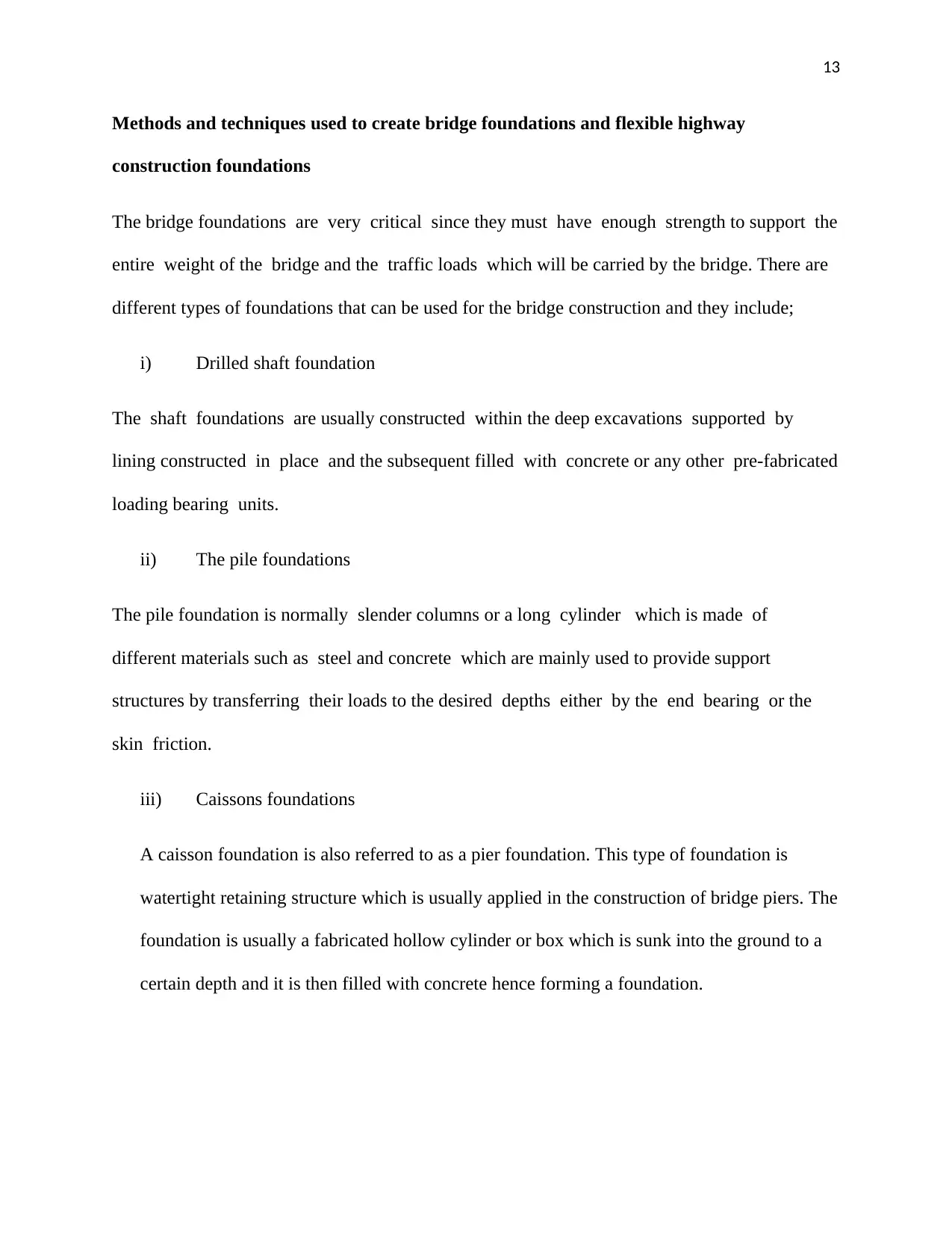
13
Methods and techniques used to create bridge foundations and flexible highway
construction foundations
The bridge foundations are very critical since they must have enough strength to support the
entire weight of the bridge and the traffic loads which will be carried by the bridge. There are
different types of foundations that can be used for the bridge construction and they include;
i) Drilled shaft foundation
The shaft foundations are usually constructed within the deep excavations supported by
lining constructed in place and the subsequent filled with concrete or any other pre-fabricated
loading bearing units.
ii) The pile foundations
The pile foundation is normally slender columns or a long cylinder which is made of
different materials such as steel and concrete which are mainly used to provide support
structures by transferring their loads to the desired depths either by the end bearing or the
skin friction.
iii) Caissons foundations
A caisson foundation is also referred to as a pier foundation. This type of foundation is
watertight retaining structure which is usually applied in the construction of bridge piers. The
foundation is usually a fabricated hollow cylinder or box which is sunk into the ground to a
certain depth and it is then filled with concrete hence forming a foundation.
Methods and techniques used to create bridge foundations and flexible highway
construction foundations
The bridge foundations are very critical since they must have enough strength to support the
entire weight of the bridge and the traffic loads which will be carried by the bridge. There are
different types of foundations that can be used for the bridge construction and they include;
i) Drilled shaft foundation
The shaft foundations are usually constructed within the deep excavations supported by
lining constructed in place and the subsequent filled with concrete or any other pre-fabricated
loading bearing units.
ii) The pile foundations
The pile foundation is normally slender columns or a long cylinder which is made of
different materials such as steel and concrete which are mainly used to provide support
structures by transferring their loads to the desired depths either by the end bearing or the
skin friction.
iii) Caissons foundations
A caisson foundation is also referred to as a pier foundation. This type of foundation is
watertight retaining structure which is usually applied in the construction of bridge piers. The
foundation is usually a fabricated hollow cylinder or box which is sunk into the ground to a
certain depth and it is then filled with concrete hence forming a foundation.
Paraphrase This Document
Need a fresh take? Get an instant paraphrase of this document with our AI Paraphraser
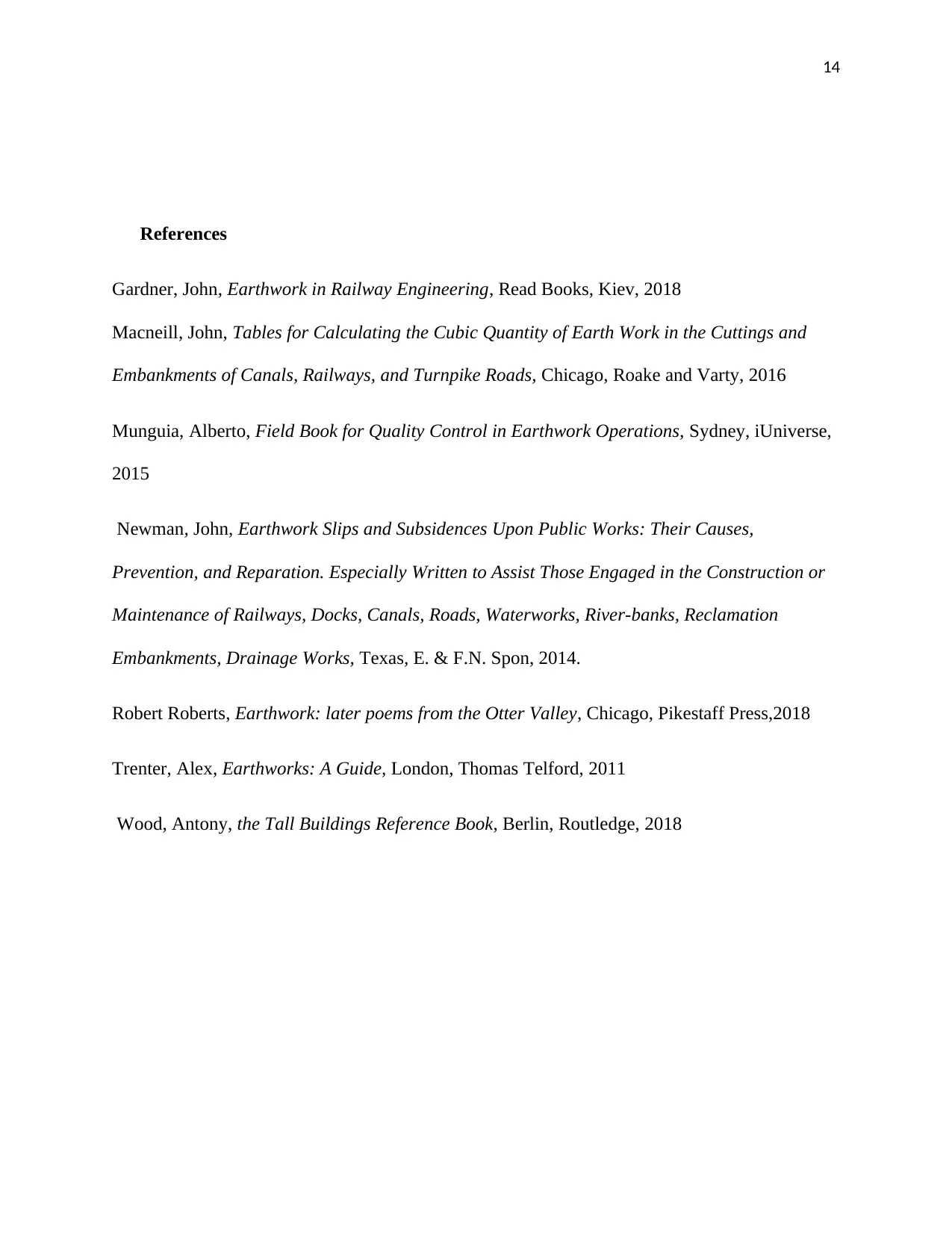
14
References
Gardner, John, Earthwork in Railway Engineering, Read Books, Kiev, 2018
Macneill, John, Tables for Calculating the Cubic Quantity of Earth Work in the Cuttings and
Embankments of Canals, Railways, and Turnpike Roads, Chicago, Roake and Varty, 2016
Munguia, Alberto, Field Book for Quality Control in Earthwork Operations, Sydney, iUniverse,
2015
Newman, John, Earthwork Slips and Subsidences Upon Public Works: Their Causes,
Prevention, and Reparation. Especially Written to Assist Those Engaged in the Construction or
Maintenance of Railways, Docks, Canals, Roads, Waterworks, River-banks, Reclamation
Embankments, Drainage Works, Texas, E. & F.N. Spon, 2014.
Robert Roberts, Earthwork: later poems from the Otter Valley, Chicago, Pikestaff Press,2018
Trenter, Alex, Earthworks: A Guide, London, Thomas Telford, 2011
Wood, Antony, the Tall Buildings Reference Book, Berlin, Routledge, 2018
References
Gardner, John, Earthwork in Railway Engineering, Read Books, Kiev, 2018
Macneill, John, Tables for Calculating the Cubic Quantity of Earth Work in the Cuttings and
Embankments of Canals, Railways, and Turnpike Roads, Chicago, Roake and Varty, 2016
Munguia, Alberto, Field Book for Quality Control in Earthwork Operations, Sydney, iUniverse,
2015
Newman, John, Earthwork Slips and Subsidences Upon Public Works: Their Causes,
Prevention, and Reparation. Especially Written to Assist Those Engaged in the Construction or
Maintenance of Railways, Docks, Canals, Roads, Waterworks, River-banks, Reclamation
Embankments, Drainage Works, Texas, E. & F.N. Spon, 2014.
Robert Roberts, Earthwork: later poems from the Otter Valley, Chicago, Pikestaff Press,2018
Trenter, Alex, Earthworks: A Guide, London, Thomas Telford, 2011
Wood, Antony, the Tall Buildings Reference Book, Berlin, Routledge, 2018

15
1 out of 15
Related Documents
Your All-in-One AI-Powered Toolkit for Academic Success.
+13062052269
info@desklib.com
Available 24*7 on WhatsApp / Email
![[object Object]](/_next/static/media/star-bottom.7253800d.svg)
Unlock your academic potential
© 2024 | Zucol Services PVT LTD | All rights reserved.




